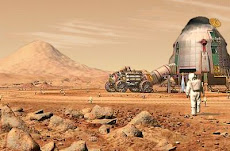Feast your eyes on the latest Mars panorama, shared generously by Ken Kremer and Marco Di Lorenzo (and based on the cool imagery from NASA and JPL-Caltech).
http://photoblog.nbcnews.com/_news/2013/03/23/17431884-mars-curiosity-rover-gets-back-to-sending-snapshots?lite
Saturday, March 23, 2013
Monday, March 18, 2013
Is there life on Mars? Why the question still eludes NASA...
Is there life on Mars?
Why the question still eludes us after 40 years of NASA discovery on Mars?
NASA is slowly learning where to look for microbes on the Red Planet, but there are no answers yet
By Carl Franzen
"For NASA, nearly 40 years after it first landed on Mars, it remains too early to make that call. The agency right now is just concerned with proving habitability, which the Curiosity rover seems to have effectively done. NASA's next mission to Mars, an orbital craft called MAVEN, is due to launch later this year to study Mars's atmosphere. The mission after that, InSight, due to launch in 2016, will be another lander that will bore deeper into Mars than even Curiosity can, revealing yet more data on Mars' past. Still, it's doubtful either of these missions will settle the question of life once and for all."
READ all of the article at : http://www.theverge.com/2013/3/14/4100578/life-on-mars-still-elusive-after-curiosity-viking-other-discoveries
Why the question still eludes us after 40 years of NASA discovery on Mars?
NASA is slowly learning where to look for microbes on the Red Planet, but there are no answers yet
By Carl Franzen
"For NASA, nearly 40 years after it first landed on Mars, it remains too early to make that call. The agency right now is just concerned with proving habitability, which the Curiosity rover seems to have effectively done. NASA's next mission to Mars, an orbital craft called MAVEN, is due to launch later this year to study Mars's atmosphere. The mission after that, InSight, due to launch in 2016, will be another lander that will bore deeper into Mars than even Curiosity can, revealing yet more data on Mars' past. Still, it's doubtful either of these missions will settle the question of life once and for all."
READ all of the article at : http://www.theverge.com/2013/3/14/4100578/life-on-mars-still-elusive-after-curiosity-viking-other-discoveries
Labels:
Carl Fransen,
History of Mars,
Life on Mars,
Mars,
NASA,
RED PLANET
Tuesday, March 12, 2013
The Chances of Life Being in Mars' History Just Got Better.
This image released by NASA shows the Curiosity rover holding a scoop of powdered rock on Mars. The rover recently drilled into a Martian rock for the first time and transferred a pinch of powder to its instruments to analyze the chemical makeup. Credit NASA
Mars's Gale Crater was habitable in its distant past, perhaps during the same period in which microbial life was establishing itself on Earth between 3 billion and 4 billion years ago.
The issue of habitability is "in the bag," said John Grotzinger, a planetary geologist at the California Institute of Technology in Pasadena, Calif., and the mission's lead scientist, during a press briefing announcing the results today, March 12, 2013.
The minerals in the tiny, gray, ground-rock sample exposed by Curiosity's drill speak of abundant standing water, conditions neither too acidic or too alkaline for life, and the minerals that would have provided a ready energy source for microbes, if any had been there.
The water in the Gale Crater being explored by Curiosity would have been "so benign and supportive of life that probably if this water was around and you had been on the planet, you would have been able to drink it," Grotzinger said. Did Mars ever host environments suitable for life? Yes is the conclusion scientists have reached after NASA's Mars rover Curiosity analyzed the first sample ever culled from deep in a rock on another planet. Curiosity used a first-of-its-kind drill to extract the sample.
Subscribe to:
Posts (Atom)





